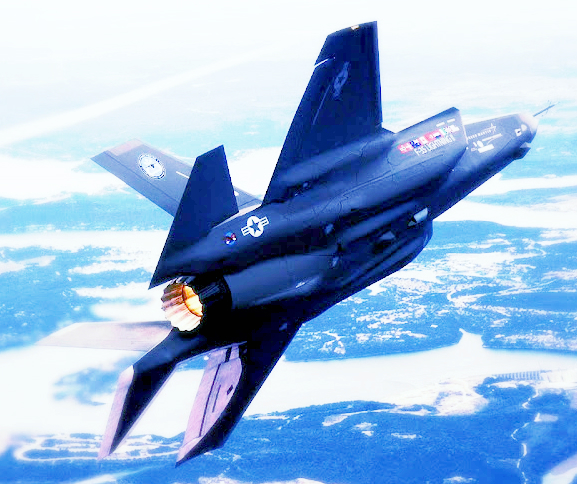The Lockheed Martin F-35 Lightning II consists of a family of single seats, single engine and it’s main role as a stealth multi-role fighters under development to undergo ground attack, reconnaissance and air defense missions.
The Lockheed Martin F-35 was designed to be the ultimate answer to the future multi-role fighter requirements. Built in 3 variants, the manufacturer could build over 3,000 of these aircraft, with a high production rate designed to minimize costs. But, as the testing continues on the aircraft, questions mount as to whether the Lightning II will give a promising delivery.
The F-35 redefines fighter aircraft, surpasses all expectations and is getting progressively cheaper. Though some experts say that the F-35 is fundamentally flawed on several levels, over budget, performing poorly and already proving that it cannot meet all promises that have been made.
The F-35 offers a wide range of advanced technologies to meet a number of mission roles. Multiply this by 3 variants and a range of requirements, the result would be a very complex aeroplane. The Lightning II's cockpit on the other hand is nothing short of revolutionary. A large liquid-crystal color display dominates the cockpit. This aircraft has been designed to be extremely simple and user-friendly.
'Finger on glass' brings the pilot everything from navigation and threat warnings to target designation and ordnance display. The most amazing feature is the 80 x 20 in-touch-screen. Lockheed Martin preferring this approach for a quick decision-making compared to voice-control.
SPECIFICATIONS:
General characteristics
- Crew : 1
- Length : 51.4 ft (15.67 m)
- Wingspan : 35 ft (10.7 m)
- Height : 14.2 ft (4.33 m)
- Wing area : 460 ft² (42.7 m²)
- Empty weight : 29,300 lb (13,300 kg)
- Loaded weight : 49,540 lb (22,470 kg)
- Max takeoff weight : 70,000 lb (31,800 kg)
- Power plant : 1 × Pratt & Whitney F135 afterburning turbofan
- Dry thrust : 28,000 lbf (125 kN)
- Thrust with afterburner : 43,000 lbf (191 kN)
- Internal fuel capacity : 18,480 lb (8,382 kg)
- Max speed : Mach 1.6+ (1,200 mph, 1,930 km/h) (tested to Mach 1.61)
- Range : 1,200 nmi (2,220 km) on internal fuel
- Max G-limits : 9 g (4.6 g in a sustained turn)
- Service ceiling : 60,000 ft (18,288 m) (tested to 43,000 ft)
- Rate of climb : classified (not publicly available)
- Wing loading : 107.7 lb/ft² (446 kg/m²; 526 kg/m² loaded)
- Thrust/weight : With full fuel: 0.87 | With 50% fuel: 1.07
- Combat radius : 401 kg/m²
- Guns : 1 × General Dynamics GAU-22/A Equalizer 25 mm (0.984 in) 4-barreled gatling cannon, internally mounted with 180 rounds
- Hard-points : 6 × external pylons on wings with a capacity of 15,000 lb (6,800 kg) and two internal bays with two pylons each for a total weapons payload of 18,000 lb (8,100 kg) | Missiles: Air-to-air missiles : 1) AIM-120 AMRAAM 2) AIM-9X Sidewinder 3) IRIS-T 4) MBDA Meteor (pending further funding) | Air-to-surface missiles : 1) AGM-88 AARGM 2) AGM-158 JASSM 3) Brimstone missile / MBDA SPEAR 4) Joint Air-to-Ground Missile 5) Storm Shadow missile 6) SOM | Anti-ship missiles : 1) JSM 2) LRASM | Bombs: 1) Mark 84, Mark 83 and Mark 82 GP bombs 2) Mk.20 Rockeye II cluster bomb 3) Wind Corrected Munitions Dispenser capable 4) Paveway series laser-guided bombs 5) Small Diameter Bomb (SDB) 6) JDAM series 7) B61 nuclear bomb 8) AGM-154 JSOW
- Northrop Grumman Electronic Systems AN/APG-81 AESA radar
- Lockheed Martin AAQ-40 E/O Targeting System (EOTS)
- Northrop Grumman Electronic Systems AN/AAQ-37 Distributed Aperture System (DAS) missile warning system
- BAE Systems AN/ASQ-239 (Barracuda) electronic warfare system
- Harris Corporation Multifunction Advanced Data Link (MADL) communication system



No comments:
Post a Comment